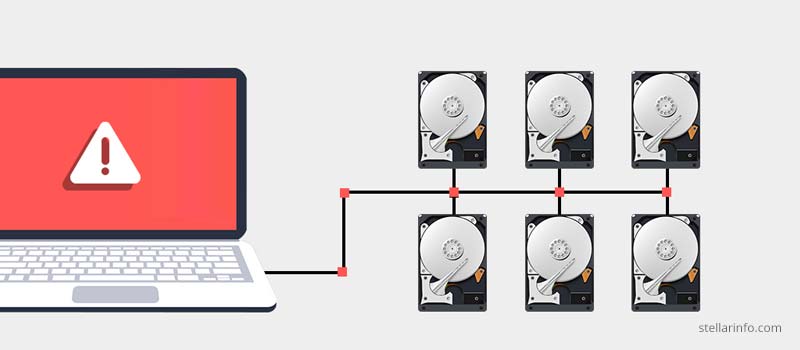Summary: The guide helps you understand various reasons that may lead to an inaccessible RAID and solution to recover data from such inaccessible RAID 0, RAID 5, and RAID 6 volumes with the help of Stellar Data Recovery Technician software. Get the software now!
- Why RAID Becomes Inaccessible?
- Precautions You Must Take Before Fixing Inaccessible RAID.
- Recover Data from Inaccessible RAID Array
- How to Fix Inaccessible RAID?
- Tips to Avoid Inaccessible RAID and Data Loss
- Conclusion

Redundant Array of Independent Disks or RAID is a logical arrangement of two or more disks that acts as one single volume and facilitates features such as data redundancy, faster I/O speeds, or both. When this logical arrangement breaks or gets damaged due to an error such as virus intrusion, power failure, etc., the RAID volume becomes corrupt and inaccessible.
In a nutshell, a RAID is a data storage virtualization technology that helps improve performance and provides protection against data loss due to drive failure. However, RAID volumes are susceptible to failure due to logical errors, which can lead to inaccessible RAID and severe data loss.
So, if your RAID volumes are not accessible anymore, here’s what you need to do to recover data and fix the inaccessible RAID array.
Why RAID Becomes Inaccessible?
There could be several reasons that can cause a RAID to become inaccessible. Following are the 5 most common reasons why a RAID may become inaccessible.
1. RAID Controller Failure
RAID controller is a hardware device (physical card or a chip on the motherboard) or software program located between the storage drives and the OS. If this controller is damaged due to any reason such as power failure, force shutdown, server crash, etc., RAID may become inaccessible.
In such cases, you should replace the controller. However, the controller should be the same as the failed one, otherwise it may damage the RAID data.
2. Disk Errors
Common disk errors, such as file system damage, can also lead to inaccessible RAID. This may happen due to virus or malware intrusion, server crash, power failure, etc.
3. Bad Sectors
Bad sectors are usually found in old hard drive or drives with a mechanical problem. When a sector is marked as bad, any data stored in the sector becomes unreadable. So, if a sector that went bad contains RAID metadata, it can lead to inaccessible RAID.
4. Server Crash
RAID server may crash due to failing disk, software errors, driver conflicts, or a problem with the RAID controller. After a crash, there are significant chances that a RAID may get corrupt and become inaccessible.
5. Multiple Disk Failure
RAID configurations such as RAID 5 and RAID 6 can withstand up to one or two disk failure respectively without data loss. However, if multiple drives fail or shutdown due to drive errors, overheating or similar errors, the RAID may become inaccessible and cause permanent data loss situation.
Precautions You Must Take Before Fixing Inaccessible RAID
To avoid any further damage to RAID and inaccessible data stored in it, do not attempt to fix or troubleshoot an inaccessible RAID before you recover your data. Doing so may cause permanent and irreversible data loss. Also,
- Do not run CHKDSK command on an inaccessible RAID array
- Never attempt to rebuild a RAID 5 or RAID 6 array with more than one disk failure
- Avoid any hit & trial methods
- Remove hard disks from the RAID array and check their health/SMART status. If disk health is poor, immediately clone it by using Stellar Drive Monitor
Recover Data from Inaccessible RAID Array
If your RAID is inaccessible and you can’t access your data, consider using a specialized RAID recovery software such as Stellar Data Recovery Technician. This powerful software rebuilds a virtual RAID configuration and helps you recover data on a single hard disk.
Once data is recovered, you can go ahead, format all RAID disks and reconstruct a new RAID array.
Here are the steps that you can follow to recover data from a logically damaged or inaccessible RAID array.
The software supports all Windows-based RAID 0, RAID 5, and RAID 6 arrays and RAID controller manufactured by Intel®, Gigabyte®, Asus®, etc. You can also use it to recover data from PCIe RAID Controller cards and software-based RAID arrays.
How to Fix Inaccessible RAID?
There’s no universal way to fix an inaccessible RAID array. If you want to fix a broken or inaccessible RAID, format all RAID disks, check their SMART health status, and then rebuild a new RAID array.
This will save you time and resources. However, before you fix an inaccessible RAID, recover your data.
Tips to Avoid Inaccessible RAID and Data Loss
- Choose the RAID level carefully. Here’s a detailed guide you can refer to how to choose the best RAID level.
- Take regular backup of your data stored on RAID.
- Buy and use RAID ready hard drive to build a RAID array.
- Install reliable antivirus/malware protection.
- Do not defragment or run CHKDSK on a RAID array.
- Keep an eye on RAID disk health and SMART status. Replace them as soon as symptoms of RAID drive failure starts to appear.
Conclusion
An inaccessible RAID array is a critical situation that may lead to permanent data loss. Thus, instead of repairing and fixing an inaccessible RAID, you must first recover the data by using a specialized RAID data recovery software. This software rebuilds a virtual RAID construction, even if you don’t know the RAID parameters, and facilitates data recovery. You can also find and recover data from lost RAID partitions.
Once data is recovered, you can go ahead and fix the broken or inaccessible RAID by replacing the faulty hardware or software. You may also reconstruct the RAID from scratch by formatting all RAID disks.
For more help, leave a comment or get in touch with us via our Self Help & Support page.